XCOM: Enemy Unknown – Review
by Stu
|
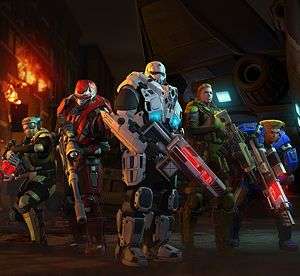 Underdogs. We love them. We root for them as they fight seemingly hopelessly against a foe that outclasses them in almost every aspect; be it films, games or real life most people want the underdog to pull it off. In XCOM: Enemy Unknown you are that underdog, except it isn’t just you – a lone hero fighting the good fight – it’s the entire human race.
Underdogs. We love them. We root for them as they fight seemingly hopelessly against a foe that outclasses them in almost every aspect; be it films, games or real life most people want the underdog to pull it off. In XCOM: Enemy Unknown you are that underdog, except it isn’t just you – a lone hero fighting the good fight – it’s the entire human race.
In 2015 a series of unexplained events and abductions leads to the forming of a secret organisation known as XCOM; its mission to identify the threat and then remove it. It has the finest scientists, engineers, soldiers and weapons at its disposal with the backing of a council of nations that provide monthly funding to the effort. You are put in charge of the XCOM project and very soon you realise that despite the backing of some of the most powerful nations on the planet, you are the underdog in what is about to play out.
Sure, the premise to the game is the well-trodden path of an alien invasion sci-fi yarn, but it doesn’t matter, as the story is both the least and most important aspect of the game. The story provides the right shell in which you create your own path to glory or failure, flitting in and out, gently coaxing you through the experience but never being intrusive. You always know it’s there, via the priority missions, the odd cut-scene at major plot points and the heavy weight of the human race on your shoulders. The story won’t likely win any best plot awards, but there is no denying that XCOM: Enemy Unknown is one of those rare games where it truly is greater than the sum of its parts.
Being almost two games – a turn-based strategy and a management game – it needs that outer shell of a story to hold it all together, and other elements have to weave seamlessly between each other to make it feel natural. XCOM: Enemy Unknown manages this balance perfectly; each aspect of the game holds just as much importance and the effects of gameplay decisions and events impacting through to their counterpart.
Starting with the management side, which takes place in the XCOM base, you, the commander, decide everything from which research to pursue or objects to manufacture, through to the hiring and firing of personnel and even the base facilities. In order to organise these many facets of the game you are presented with an overview of the base – commonly referred to as the ‘ants nest’ – which as it sounds is a zoomed out cut-through of the base facilities. From here you are able to view any room you choose and see what is going on. For ease of use, a menu bar hangs across the top of the UI for each of the areas you may be interested in.
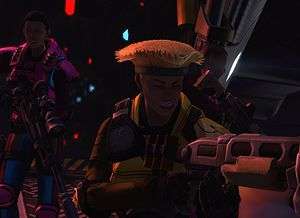 You have limited resources – especially at the beginning – and from the outset you will have to carefully consider your options, with time also a factor. Do you manufacture items to protect your men, to improve their offensive capability or concentrate on ancillary items such as satellites to keep watch over your funding nations in order to ensure they keep funding your efforts? As research gets completed, enemy incursions more frequent and manufacturing capabilities hobbled by limited resources, the question only gets bigger. XCOM: Enemy Unknown, if nothing else, forces you to make compromise after compromise, which at times will have you begging for a smooth ride until the end of the month and your pay packet from the council.
You have limited resources – especially at the beginning – and from the outset you will have to carefully consider your options, with time also a factor. Do you manufacture items to protect your men, to improve their offensive capability or concentrate on ancillary items such as satellites to keep watch over your funding nations in order to ensure they keep funding your efforts? As research gets completed, enemy incursions more frequent and manufacturing capabilities hobbled by limited resources, the question only gets bigger. XCOM: Enemy Unknown, if nothing else, forces you to make compromise after compromise, which at times will have you begging for a smooth ride until the end of the month and your pay packet from the council.
As hinted above, the base management has many tasks you need to stay on top of. As well as helping to progress the story and drop hints, three NPCs will assist you; Dr Vahlen, Dr Shen and Central Officer ‘Big-hands-man’ Bradford (seriously, the character has ridiculously huge hands) head up managing research, engineering and everything else respectively. Whilst little more than objects for the plot and narrative to work with, they provide the odd insight, squabble with viewpoints but ultimately maintain the illusion of humanity fighting against this new enemy, and that makes you consider your actions a little more carefully as we all want the underdog to win, remember?
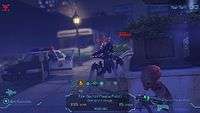 |
 |
 |
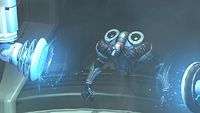 |
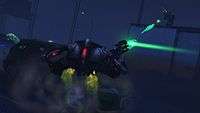 |
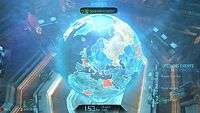 |
Research is all about progressing XCOM’s technology and knowledge about the alien invaders. You can only investigate one item at a time, and this can take anything from a day to almost a month depending on what is being researched and how well-outfitted your team are; the more scientists and laboratories you have then the quicker the results will be delivered. Research arrives as you discover new items out in the field, or sometimes studying an idea or technology will open up other related avenues. You are also able to perform autopsies on deceased aliens in order to gain insight into the alien purpose or aid in further research or manufacturing.
Engineering is then responsible for taking your research and making it a reality. Utilising various components and money you can start to outfit XCOM as a force to match – or at least try to match – the alien invaders. It can range from armour to guns, new facilities for your base or even armaments for your interceptor ships.
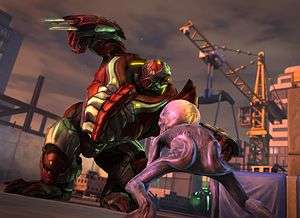 So you’ve done your research, built some fancy stuff and now you have to make use of it. The barracks is where you manage the fighting men and women of XCOM. From the barracks you can hire and fire personnel, customise their look and names, and most importantly alter their load-out. Each soldier starts as a raw recruit but after a kill or two will rise in rank to a squaddie, at this point they are assigned one of four classes: assault, heavy, support or sniper. Each of these has a specific area of expertise, I’ll save the specifics for you to explore for yourself inside the game, but as your soldiers rise in rank all the way through to colonel you can assign perks. There is no way to go back and undo your decisions either, so decide carefully.
So you’ve done your research, built some fancy stuff and now you have to make use of it. The barracks is where you manage the fighting men and women of XCOM. From the barracks you can hire and fire personnel, customise their look and names, and most importantly alter their load-out. Each soldier starts as a raw recruit but after a kill or two will rise in rank to a squaddie, at this point they are assigned one of four classes: assault, heavy, support or sniper. Each of these has a specific area of expertise, I’ll save the specifics for you to explore for yourself inside the game, but as your soldiers rise in rank all the way through to colonel you can assign perks. There is no way to go back and undo your decisions either, so decide carefully.
Moving to the hangar allows you to purchase, assign and customise your interceptor fleet. You only have one main base, but you can position up to four interceptors at air bases in each continent. Interceptors are your only method of downing enemy UFOs so they need to be updated with the latest advances in technology if you hope to take out an enemy before they destroy you or fly out of reach.
The situation room follows on the UI and displays all of the funding council countries, their panic status and how much satellite coverage you have. From here you can launch new satellites, sell unwanted items via the grey market and deal with any council specific requests, like providing them with a number of manufactured items – the rewards are usually more than worthwhile for the effort in diverting resources.
Finally, the situation room is the hub of action for this side of the game. Here you can speed up time, with upcoming events highlighted to the lower right of the UI. Sometimes you’ll be begging for a clean run until a piece of manufacturing is complete or the council payday arrives, other times you’ll be begging for a last mission in a panicked country as a desperate bid to stop them leaving the XCOM project – lose 8 council members and it’s game over, Earth.
The situation room also displays any current missions, so should you be alerted to an alien incursion, detect a vessel or get summoned by the council, it happens from there. In the event of an alien UFO entering your space then you can dispatch an interceptor craft to engage. What follows is a small skirmish between ships, played out in a display window. Whilst it is automatic, you are able to employ the odd one-time bonus such as enhanced targeting or evasive manoeuvres – that is if you’ve researched and built them.
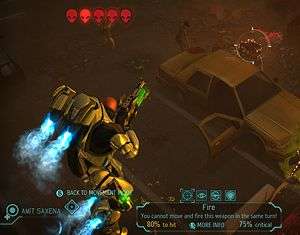 Once the situation room alerts you to a new incident or you down an enemy craft then it is time to send in your squad and the second part of the game begins, the turn-based strategy. As the mission loads you’ll be treated to a brief description of the mission and the objectives as your soldiers nervously tap feet, look around and psych themselves up for what’s in store. There are many mission types, from item retrieval, escorts, UFO crash sites and bomb deactivation, but in reality all involve wiping out every alien on the map. When embarking on the mission you are presented with an isometric viewpoint of the level; from here you guide your personnel across the terrain, from urban settings to muddy forests, with each offering cover points, elevated sniper spots and dangerously open sections.
Once the situation room alerts you to a new incident or you down an enemy craft then it is time to send in your squad and the second part of the game begins, the turn-based strategy. As the mission loads you’ll be treated to a brief description of the mission and the objectives as your soldiers nervously tap feet, look around and psych themselves up for what’s in store. There are many mission types, from item retrieval, escorts, UFO crash sites and bomb deactivation, but in reality all involve wiping out every alien on the map. When embarking on the mission you are presented with an isometric viewpoint of the level; from here you guide your personnel across the terrain, from urban settings to muddy forests, with each offering cover points, elevated sniper spots and dangerously open sections.
You’ll learn very quickly that staying in cover is the only way to keep your people alive, or have a chance of doing so. Cover is simplified into three settings: none, half, full. A shield (half or full) will display to indicate the cover your soldier has; if the shield is yellow then they are flanked and most likely not long for this world.
Moving your people about the war zone is easy enough; a blue radius indicates the area in which they can move to and then take an action, the yellow radius that extends from the blue indicates a ‘dashing’ event, whereby no further action can be taken after moving. Should you be involved in a skirmish or within the sight of an enemy you can also shoot or perform another action. However, if you do this without moving it will end your go, so you cannot make a shot and retreat should you fail to down the enemy.
 |
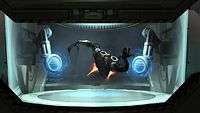 |
 |
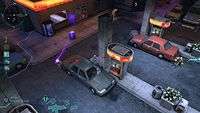 |
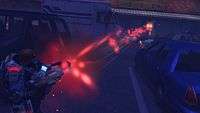 |
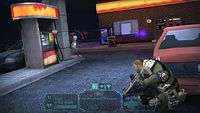 |
The camera will often zoom in of the action, for instance when a character dashes, you’ll get a chase-cam or a glorious close-up when you perform a headshot. Likewise, when discovering the enemy you are usually granted with a little cut-scene before they spill out of their hiding place into various cover spots. Small touches like these really add to the overall suspense and immersion.
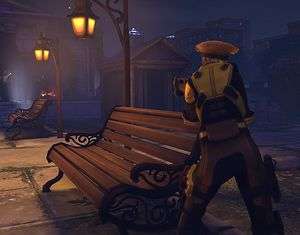 The interface for the combat missions is thoughtfully laid out; moving is dealt with by moving a cursor about the screen and selecting the destination for your soldier while actions are accessed by pressing the RT trigger (or a key on the PC) so you don’t accidentally perform an unwanted action. Pressing LS will bring up further information on either your soldier, their target or the action you have highlighted, so it is always easy to get a quick recap on your soldiers. Each character on-screen also has an indicator for health, cover and enemies they can see. If a soldier’s indicators are greyed out then they’ve spent their turn already. Firaxis have done a fantastic job of making an uncluttered, unobtrusive but richly detailed interface on both the PC and the consoles.
The interface for the combat missions is thoughtfully laid out; moving is dealt with by moving a cursor about the screen and selecting the destination for your soldier while actions are accessed by pressing the RT trigger (or a key on the PC) so you don’t accidentally perform an unwanted action. Pressing LS will bring up further information on either your soldier, their target or the action you have highlighted, so it is always easy to get a quick recap on your soldiers. Each character on-screen also has an indicator for health, cover and enemies they can see. If a soldier’s indicators are greyed out then they’ve spent their turn already. Firaxis have done a fantastic job of making an uncluttered, unobtrusive but richly detailed interface on both the PC and the consoles.
The missions are far more tactical than the move and shoot scenario above. Perks, fog of war, destructible terrain, height advantage and other aspects make each mission a new tactical challenge and that’s without throwing in the daunting prospect of not knowing when or where you may happen across your enemy. Nothing makes your heart leap into your throat like running around a corner to meet a Chryssalid or Berserker. Why are they so terrible? Heh, I’ll let you find out! Each soldier has stats for will, aim and health, and these will determine the ability of the soldier to reduce chances of panicking when a squad-mate dies or the team takes a pounding in a round. If a soldier panics then do anything from running blindly to shooting a fellow XCOM member in the back, making panic a dangerous menace to your team. If the potential to wipe out a fellow squad member isn’t bad enough, anyone who is panicked will also lose their next turn.
Each squad you take out can consist of four to six soldiers (depending on upgrades via facilities) and although it can be tempting to rely on ‘the dream team’ of highly-ranked soldiers, having backups in place is sensible and with perma-death in place for anyone who dies in the line of duty, it can be very galling to have a team of highly trained people decimated only to be left with 15 rookies back at base. Again, the decisions remain entirely with the player on how they wish to tackle levelling up of their squad members.
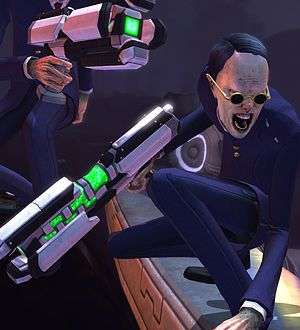 Once the mission is wrapped-up you are returned to base, your wounded taken out of action until they heal, any promotions handed out and the spoils of the battle taken to the storeroom. You can choose to pay respects to the fallen via the memorial wall in the barracks, a lovely touch by the Firaxis team with a stirring bagpipe rendition to add to the guilty feelings when viewing the pictures that accumulate over time…yep, you killed them all with your bad decisions, you evil bastard. Cpt. Snagglepants ‘Mad Dog’ McFlurkle never stood a chance after running into the UFO with a weapon that needed reloading.
Once the mission is wrapped-up you are returned to base, your wounded taken out of action until they heal, any promotions handed out and the spoils of the battle taken to the storeroom. You can choose to pay respects to the fallen via the memorial wall in the barracks, a lovely touch by the Firaxis team with a stirring bagpipe rendition to add to the guilty feelings when viewing the pictures that accumulate over time…yep, you killed them all with your bad decisions, you evil bastard. Cpt. Snagglepants ‘Mad Dog’ McFlurkle never stood a chance after running into the UFO with a weapon that needed reloading.
XCOM: Enemy Unknown is literally a game of two halves and it is so well executed that you can’t really help but be dragged into it. Sure, it may not appeal to all gamers with the hands-off, turn-based combat and base management aspects, but I’d implore everyone to give it a go. It is so rare to have a game like this, particularly on the consoles and to pass it up would be a gross injustice indeed.
Graphically, XCOM is great to look at considering a lot of it is zoomed-out, and there is rarely any slowdown, with the odd exception being the action-camera switch when in a busy mission area. Soldier character models are diverse and well-detailed; particularly the weapons and armour, although the three base NPCs could have been more detailed being by far the weakest element artistically. Mission environments are richly-detailed and although many assets are shared across maps, each feels different and unique.
The colour palette for the game is very well balanced, XCOM: Enemy Unknown manages to never scream “I’m colourful” at your eyes, but also avoids feeling like the game can’t offer up more than 4 shades of the same colour. Little things like armour decals, debris and well placed scenery bring life to what could have been a very grey urban map. Likewise, lighting and colours help sway the mood, alien abduction missions tend to be fairly bright affairs taking place in daytime, but a night-time terror mission combined with fog of war will raise the hairs on the back of your neck when you can only hear an enemy and not see it. Aliens are richly detailed and uniquely identifiable too, each one looking like it means business.
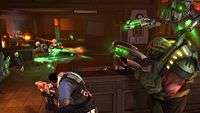 |
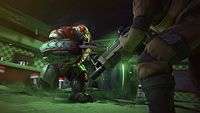 |
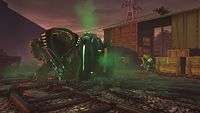 |
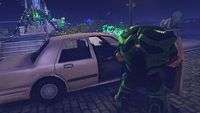 |
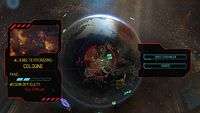 |
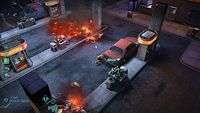 |
Although the music in XCOM is great, at times it feels like there could have been room for more variance in terms of track-lists. Despite that, what music there is adds to the mood perfectly. When in your base this is reduced to little more than a background whisper in your ears with a constant ‘dum dum dum dum’ and electronica not dissimilar from scores in Mass Effect. The situation room has a melodic, ethereal (see what I did there?) sound with no drumbeat behind it, almost like walking into a chill-out room. Moving out for a combat mission is the complete opposite, a defiant military drumbeat and rousing crescendo – reminds me of something you’d hear in a movie when the hero is getting ready to take down the big bad boss. Individually, they’re all beautiful tracks and the context sensitive music mid-mission doesn’t miss the mark either, but after many hours of play some of it does feel quite repetitive.
Sound effects are well-rounded, weapons have the right thudding sound or zap, and alien noises are equally ‘alienish’ right down to the death gurgles or shouts. The usual things you would expect are in place for walking across metal and pavement and any miscellaneous sounds are clear and well-matched.
 I’ve hinted that the user interface is useful and unobtrusive and that extends, in a manner of speaking, to the gameplay too. I found controls responsive but not too sensitive when scrolling the map, intuitive and useful in terms of shortcut mappings that remain displayed in the interface. Moving to cover is made easier with the light snap-to, but it isn’t implemented in a way that makes moving near to cover difficult. The difficulty is tough, even on normal you will be dealt some harsh blows and I think the number generation is truly randomly done, having missed several high-percentage shots and suffered the consequences. The game can be very unforgiving at times and I’m now on game fifteen, having had two successful completions and several no-win scenarios. My current playthrough is on impossible and it truly is that; I’d wager almost everyone will have to abuse the saving capability to backtrack regularly on this difficulty. For the truly hardcore there is Ironman mode, Firaxis’ salute to sadists; just one autosave and nothing else…make a mistake and lose a guy, he’s gone forever.
I’ve hinted that the user interface is useful and unobtrusive and that extends, in a manner of speaking, to the gameplay too. I found controls responsive but not too sensitive when scrolling the map, intuitive and useful in terms of shortcut mappings that remain displayed in the interface. Moving to cover is made easier with the light snap-to, but it isn’t implemented in a way that makes moving near to cover difficult. The difficulty is tough, even on normal you will be dealt some harsh blows and I think the number generation is truly randomly done, having missed several high-percentage shots and suffered the consequences. The game can be very unforgiving at times and I’m now on game fifteen, having had two successful completions and several no-win scenarios. My current playthrough is on impossible and it truly is that; I’d wager almost everyone will have to abuse the saving capability to backtrack regularly on this difficulty. For the truly hardcore there is Ironman mode, Firaxis’ salute to sadists; just one autosave and nothing else…make a mistake and lose a guy, he’s gone forever.
There is also a multiplayer mode, although it is basic and – in my opinion – unnecessary. You outfit yourself with a team of soldiers, aliens or a combination of the two and go head-to-head against another player with a similarly customised team. You both have a certain amount to spend on your team, with units like Ethereals and Cyberdiscs costing more than say, a Sectoid. This means that you can hedge your bets across the board or take in one uber guy and several grunts to soak up enemy bullets. As a deathmatch mode it is fun and short-lived, but ultimately as you don’t level anything up (which is, for once, nice to have an even playing field) there isn’t too much longevity in the mode.
XCOM: Enemy Unknown does have its foibles, like any other game. Being based on the Unreal Engine, there is the signature texture pop-in, although this is really only noticeable at the very beginning of missions. Other graphical glitches I came across involved the action-cam zooming onto a person leaning out from behind a wall to fire when the enemy was in the open, almost behind them, resulting in a spray of bullets flying out of the gun at a 90 degree angle. A couple of save glitches either froze the game or left it unplayable, like during a bomb disposal mission where after saving I could no longer disable any of the power supplies and thus failed the mission when time ran out. The Xbox version has plenty of auto-saves, usually four, so you don’t tend to lose any real amount of time should a save glitch occur. All things considered though, the very few niggly negatives cannot detract from this title being an absolute stonker to play.
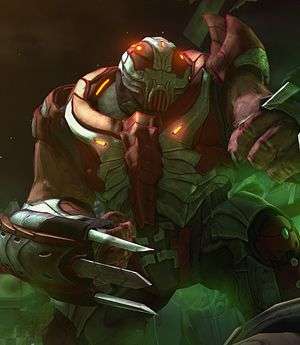 Addressing the Muton in the room
Addressing the Muton in the room
*Potential spoilers alert*
If you are aware of XCOM by playing the original upon which this game is based then you will have noticed that I omitted any comparisons throughout my review. I did this deliberately, for I felt that comparing it to the original would detract from my feelings that, despite the homage given by XCOM: Enemy Unknown to the Microprose classic, it deserves to be viewed as standalone game by today’s standards.
That said, I would like to address the whole re-imagination thing too. Obviously, the game does draw heavily from the original – particularly in terms of technology research, enemy types and especially the gameplay. In that respect it has kept itself close enough to be a recognisable ‘remake’, but Firaxis have stamped enough of their own personality into the title for it to stand shoulder-to-shoulder with the original and not as some underling or sequel.
There are some major differences to keep in mind:
- Time units replaced by the ‘two moves’ or ‘one move, one action’ setup that also replaces the aimed, snap or auto-shot options.
- Ammo is unlimited, but squad members will still need to reload.
- There is only one base.
- Missions are one at a time, you do not get multiple Skyrangers but you can send whoever you want (up to the four to six limit) if unwounded.
- Simplified research and engineering.
- Simplified air-to-air combat.
- Soldiers don’t have an inventory like the original or the ability to scavenge on the map.
- Flanking and height advantage introduced.
Naturally there are probably several things I’ve missed off that list that seem minor to me but are a big deal for others. Once I started playing this XCOM reboot, I soon began to revel in the updated graphics and the simplified management of things; if anything I enjoyed the gameplay more as could get more tactical in combat and worry less about inventory management. The game knows it has borrowed heavily from the original, a nice nod to the Gallop brothers with the ‘Gallop Chamber’ late into the game, the use of the original Sectoid interrogation graphic on a target when you discover laser weapons, hell, even most of the aliens retain their names and abilities from the original. XCOM: Enemy Unknown even inherits the harsh, unforgiving scenarios of the original too.
I also neglected to mention things like psi-powers, advanced ships & weapons, tanks and facilities (which are all in the remake) as half of the magic for both games was the first playthrough where you were learning everything fresh (or going “ooh ooh, it’s got that too!” if, like me, you are a veteran of the original). For the latest generation of gamers who may have this title as their first exposure to the genre, or at least to XCOM, I want them to see it with fresh eyes and not have a cloud of comparison with its forebears hanging over it, especially when the predecessor it’s being compared to is over fifteen years old.
So is XCOM: Enemy Unknown better than XCOM: UFO Defense? Technically, graphically, and in terms of playability, yes, I think it is, but the original still has a certain charm and addictive quality, even now, and that won’t likely ever change. For some people the original will always be the best; they are two very similar games, but at the same time quite separate, they excite me in different ways. Ultimately, I refuse to choose a winner and, instead, choose to play both.
For all the clones, wannabes and fan attempts at recreating the XCOM vibe, this is the first attempt to have truly succeeded. That statement in itself should tell you everything you need to know ,and sums up my feelings for XCOM: Enemy Unknown perfectly.
Pros- Despite being almost two separate games, it is a joined up and immersive experience.
- Addictive gameplay, especially when you start ranking up soldiers and naming them...it’s amazing how attached you become.
- One of the most polished games on release I’ve played for a while.
- Fantastic UI.
- Fun. So much fun.
- Succeeds in rebooting the XCOM franchise the right way.
- Some minor glitches with graphics and saves, which if in Ironman mode could destroy your progress (although I haven’t had that issue yet with an Ironman playthrough).
- Music could have done with a few more tracks.
I honestly cannot recommend this game highly enough. In a year where we have been spoiled by great releases - from both AAA publishers and indie outfits - I can place my hand on my heart and say nothing has captivated me like XCOM: Enemy Unknown. It won’t be to everyone’s taste, but I think that is what helps make it great; Firaxis make no apologies for making this a tough, engaging and an out-and-out strategy experience. In a time when I rarely play a game twice through to completion, this will keep coming out to get played again. Sure, I may play other titles in and around it, but it is so accessible, addictive and different that it will likely keep a coveted spot next to the Xbox for a long time to come.
Last five articles by Stu
- When A Choice Isn't Really A Choice At All
- Best of 2013: Next-Gen: #Fail
- Deadfall Adventures - Review
- Assassin's Creed IV: Black Flag - Review
- The Inner World - Review





















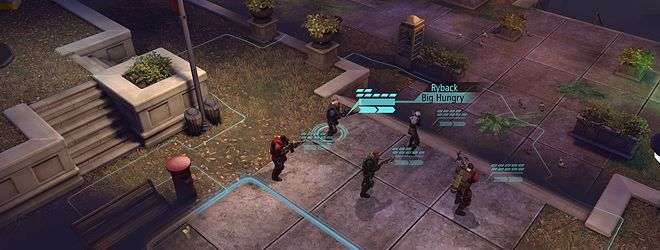
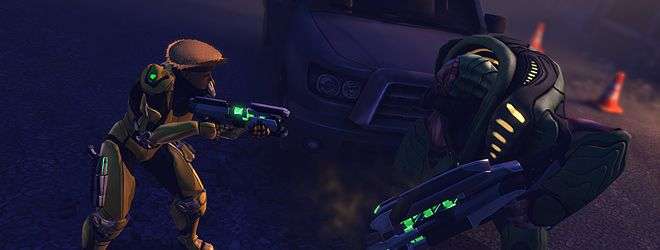






I love this game so much. It captivated me from the first day I played it, and I never even played the original. This is a brilliant game in and of itself, and if it has done the original proud as well then I have all the more respect for it.
Brilliant game.
Great review mate. It’s top of my Xmas list!
I loved the original and played it on 3 differant formats inlcuding when it was actually first released. I bought it on release, but I just cannot drag myself away from Borderlands 2 to start playing it, it’s definately next on my list though. (I did kinda spend over 1000 hours on Borderlands 1, it’ll be worth the wait)
Absolutely stellar review, Stu! Pretty much encapsulates exactly why I love this game so much